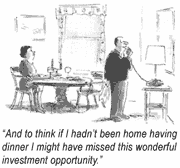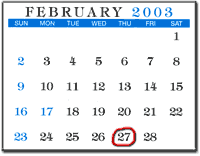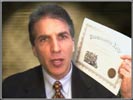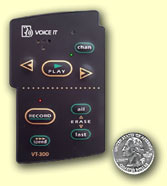Investment Scams – We Won't Get
Fooled Again 
It's an odd time to be writing about investing. Many people I know
don't even open their monthly brokerage statements anymore. It's too painful.
Personally, I'm "hunkered down in a bomb shelter with an AK-47…" focused more on
protecting what's mine than on making a fortune. But one day, the "all clear"
siren will blow, and we'll surface… ready to do battle in the investment arena
once again. When the future seems bright, 2% on a 12-month CD seems pretty dim.
And just 3½% on a 5-year? Black as night. We used to see at least that much every
month. No, we'll be back, actively investing and looking for the double-digit
returns again soon enough. And the scam artists will be waiting for us.
Swindlers love investment scams. All the right elements are there: big money,
greed, and misinformation – everything needed to separate "investors" from their
hard-earned dollars. And make no mistake: those dollars are hard-earned. No more
play money. We've sweated and suffered for every dime. Here's what you need to
know to keep your money safe:
The Internet: Investor's Friend? Or Foe? If you know
how to do Internet research, it can be an awesome tool for investigating
investment opportunities. But tech-savvy swindlers also fancy the Internet. It's their very
best tool for pulling the wool over our eyes. Be very suspicious about any
opportunity you first learn about online. It's all too easy for scammers to
build an impressive (sham) web site, post compelling (yet phony) messages on
online message boards, and blast out "investment alert" emails by the millions.
Technology has made it easy for criminals to make their communications appear
very real and credible. However, it is virtually impossible for investors to
tell the difference between fact and fiction – based solely upon what we see
on our computer screens.
Investment Newsletters. In the heyday (late 90's),
over a thousand stock-picking newsletters circulated on the Internet.
Many still exist, and others will surely bloom again once the markets recover.
These letters appear to offer investors unbiased information about
featured companies. Some charge for this information but the majority are free.
Many are legitimate but some are not. Sometimes, the writers of these advisory
letters will be compensated (with cash and/or securities) to "tout" the stocks
of particular companies – by those in a position to profit from an increase in
share price, or "bash" the stock, if a decrease is desired by the manipulators.
Surprisingly, this practice is NOT always illegal, provided there is full
disclosure by the writers: who paid them, how much, type of payment, etc. The
unscrupulous publishers don't disclose, or they misrepresent. They hold
themselves out as independent providers of unbiased information, claim they do
in-depth research on the companies listed, and fabricate bogus track records of
success. The bottom line is they stand to profit handsomely if their "advice"
convinces investors to buy or sell particular targeted stocks. Be very wary of
supposed investment "gurus."
Online Forums: Beware the "Pump and Dump."
Yahoo! Message Boards, Lycos Raging
Bull, Silicon Investor,
and seventy more (see full listing at
www.boardcentral.com) are home to thousands of active company-specific
discussion boards. Sometimes known as "bulletin boards," these forums contain
ongoing message "threads" contributed by individual, often anonymous writers.
While some messages contain well-thought out analyses of investment
opportunities, forums are not the place to make specific investment decisions.
People will often pump up a company or pretend to have inside information about
favorable announcements, new products, and big contracts. If they are successful
in pumping up the stock price, they'll dump their holdings at a profit at the
first opportunity (the classic pump & dump). You simply cannot tell who is
telling the truth, and never know for certain who the writer is. Most boards
permit users to hide their true identity behind online aliases. It's easy for a
single individual to create multiple aliases and create the illusion of
widespread interest in a thinly-traded stock.
"Investor Alert" E-mails: A.K.A. Spam.
Have you ever heard of "Cal-Bay International, Inc." or its stock
symbol CBYI? Well, I sure have. In the past year some %*@$*# (expletives
deleted) promoter has sent
me well over a thousand spam messages touting this company. By some accounts, this has
been the largest stock-related spam campaign ever, with hundreds of millions of
messages sent. Here's the full story if you're interested:
Cal-Bay Spam.
I hope I don't need to say this, but I will anyway:
Never – under any
circumstances – invest based on
information you receive via unsolicited spam
email!
Instead, forward it to this special email address at the Securities &
Exchange Commission dedicated to stock promotion spam: [email protected].
|
So... You really want to invest in that company?
When it comes to manipulating information, stock scammers have
the upper hand. Now that we've learned (the hard way) that even large public
companies and their brand name accounting firms are capable of heinous financial
misrepresentation, you must do your own due diligence on *every* substantial
investment you make. Here are the new rules:
Rule #1: Never make an investment – large or small – based
solely on what you read in a newsletter, a forum posting, or a web site.
Rule #2: If the investment involves a small, thinly-traded
company, put your "B.S. detector" on maximum. Assume everything you hear and
read is half-true at best.
Rule #3: Worst case scenarios happen. We used to go lightly
over the "Risk Factors" section of the offering. Can't do that anymore. If you
can't live with the WCS, don't invest.
Rule #4: Ask tough questions. It's a buyer's market right now.
People trying to raise funds are having an incredibly tough time. Unfortunately, that
desperation can lead
some to bend the truth. Your best defense is to ask tough, direct questions – and
verify every answer you get. Here's a good list, prepared by the SEC, to get you
started: Questions
You Should Ask About Your Investments… and What To Do If You Run Into Problems.
Rule #5: Be prepared to dig deep. Get financial statements and
analyze them yourself. Personally verify any claims regarding new contracts or
product releases. Contact major customers and ask if they really buy from the
company. Call key vendors and ask about their relationship to the firm. Finally,
and most importantly, do an in depth background check on the major players at
the company. Make absolutely certain they are who they claim to be… and that
they've "been there and done that" (which means: they've made real money for
other investors before – and are ready to do it again for you).
Rule #6: Check EDGAR. Most public companies are registered
with the SEC and file quarterly/annual financial statements. These reports are
archived in the EDGAR
database and are available for review at no charge to you. You should also check with your
state
securities commission for additional company information, and the
NASD to check
for any disciplinary actions filed against the broker or promoter.
|
Off-shore Fraud. If the
investment involves off-shore entities, you must be extra vigilant against a
possible scam. If you get ripped-off, you'll have little recourse. The SEC and
U.S. law enforcement agencies will generally not investigate and prosecute
foreign frauds. The bad guys know this and act more boldly than they would in a
domestic swindle.
Promissory Note Scams. Promissory notes are typically issued to raise money in the
form of corporate debt. Promissory note scams have recently targeted affluent
older people, who traditionally viewed them as safe, lucrative investments. Like
a bond (but less regulated and structured), the note is an agreement stating the
company will pay back the amount invested, plus interest, over a period of time.
However, promissory notes are institutional investments, and are not typically
sold to individual investors. Those that are promoted to individuals often turn
out to be scams. The "investor" receives a very official-looking promissory note
certificate, complete with gold embossed seals, etc. Even if the note is real,
there's often no collateral behind it, and victims usually end up losing all of
their investment. Be aware these notes are sometimes sold by life insurance
agents, who are enticed by high commissions and the mistaken belief they don't
need to be licensed to sell them.
If there's a common thread to all investment cons and scams
it's this: the promise of large financial rewards at low risk. However, one of the iron
laws of investing is the relationship between risk and reward. The higher the
potential return on investment, the higher the risk of default or loss. The
marketplace is very good at establishing norms for legitimate transactions.
However, con
artists will try to convince you that, "This one is different," and dangle a
"risk-free, high-yield" opportunity. Uh, huh. Right. If it sounds too good to be
true…
Spread the Word
|

|
I hope you're enjoying this issue of The Urbach
Letter. If you are, the highest compliment you could pay me
would be to share my advisory letter with a friend or business
associate who would find it of value. I've made that easy to do.
Just click the blue button and I'll start an email message for
you, with some suggested text to invite your friend. Feel free
to edit it to say anything you want. Thanks so much.

Tell a Friend About The Urbach Letter
|
|

The Answer Line
I'll do my best to answer your business and
marketing questions. Please send them to me at
[email protected].
Reader's Question: I need to send out a sales letter. How do I
create one that won't end up in the reader's "round file?" Help!
Great question. If you've got something to sell or
promote (and who doesn't?) a paper and ink sales letter package is
going to be one of the most powerful and cost-effective marketing
devices you can deploy. Even though we're living in the age of the
Internet, the plain old fashioned sales letter hasn't gone away. Not
by a long shot. Some say their sales letters are pulling better than
ever. What's happened is that postal volume has gone down.
Most likely, you're receiving fewer personally addressed letters
these days, so when you get one that looks like it was individually
mailed to you, it stands out and makes a bigger impact.
Here's a mini-tutorial on creating a great letter package that'll generate
sales leads, open doors, collect money, or help close deals. There are five or
more elements to the traditional sales letter: (1) the letter itself, (2) a
reply card, (3) a reply envelope, (4) a "brochure," and (5) the outer envelope.
The most important element is the letter – by far. A letter is a personal
conversation between you and the reader. No matter if you're sending out one or
one million letters, write it like you were writing to your best friend, telling
him or her about the wonderful product or service you've just discovered. Write
about how it's going to benefit the reader (save money, reduce effort, protect
assets, enhance the home or workplace, prevent problems, etc.). Explain why it's
different and better. Back up what you say with proof (certifications, article
references, testimonials, etc.). Build value. Make a clear and compelling offer.
Ask for a specific response. These are the fundamentals of a great sales letter.
The letter does the selling. Everything else in your letter package just
exists to support the sale. For example: the reply card. In a traditional "mail
order" sales letter package, this is an order card, with the offer restated, blanks for
name, address, etc., and return instructions. You're probably not doing mail
order, but it may be worthwhile to include some sort of reply card in the
package, even if it just contains your telephone number and/or link to your web
site, along with a summary of your offer. A business
card with a handwritten note on the back can often serve well in this role.
In the old days, most people wrote a check and put it in the reply
envelope – then waited "four to six weeks for delivery." How quaint! These days,
people call a toll-free number or go online to order, and then expect to receive
their package by FEDEX the next morning. Therefore, you're pretty safe skipping
the reply envelope.
In my opinion, brochures are overrated for most businesses (with some
exceptions, like travel destinations and highly visual trades). A brochure can
often be omitted – if you've got a great letter. I realize this runs counter to
the conventional wisdom, where most of the effort and budget goes into design
and production of a glitzy full-color brochure… that nobody reads.
Your last major element is the outer envelope. The more your envelope looks
like a secretary individually typed it, the better. Unless you have an existing
business relationship with the reader, you'll probably get a better response
with just your typed name and return address rather than a logo envelope. And
unless you're very good at writing "teaser copy" (the headline-like "kicker" on
the envelope), don't include it at all. Under no circumstances use labels for
the recipient or return address. People open their mail over a garbage can and
they're itching for a reason to save the effort of opening the envelope. A label
screams, "Toss me."
Of course, you can hire professionals to help with your mailing project.
However, nobody knows your products and services better than you, or has a more
direct connection with your customers and potential customers than you.
Therefore, even if you delegate the production elements, there's no substitute
for your creative direction.


Save The Date
Mark your calendar. The date: Thursday, February 27th, 2003.
The time: 8 AM to 10 AM. The place: Milleridge Inn, Jericho, NY.
Please save the date and plan to join me for a
business breakfast seminar. I'm teaming up with two other great
speakers and we're planning a terrific morning program. No charge
for Urbach Letter subscribers; you'll attend as my guest. Details to
follow shortly.
Wrap-Up
That's all for this month. I'll be back in February with more.
Please feel free to drop me a note with feedback, suggestions, or attaboys. I'm very reachable at
[email protected]
Subscribe
I hope you liked this issue of the
Urbach Letter. Click
Here to Subscribe Today
The Urbach Letter may be freely
redistributed if copied or forwarded in its ENTIRETY. Portions
of this newsletter may be
reprinted with permission.
(c) Copyright 2003 Victor Urbach
|
|
|
In this Issue
|
The Urbach Letter Video Magazine

I know you're busy... Maybe too
busy to read my whole letter right now. Well, I've got just the
thing for you. Just click on this button for a fast-moving
two-minute video overview of this issue right in your web
browser:

January 2003 Urbach Letter Video Magazine
Cool Thing of the Month

The Voice-It
You've got a hands-free cell phone kit in your car. Great. But
when you're driving down the road and someone starts giving you
detailed information... phone numbers, addresses, account numbers,
dates, prices… are you going to try and write all that down at
sixty miles an hour? That's a bad idea.
Here's a good one: get a
Voice-It… a tiny solid-state recording device that clips on
to your sun visor. Push one button and record up to six minutes
of detailed notes. Push another to play back. It's like a
mini-tape recorder, but with no tapes to jam or degrade. You may have seen other
digital mini-recorders. Most are too
complicated, big, and expensive for what you really need: to
simply jot some verbal notes while you're barreling down the
highway. With just a few essential (tactile) buttons, the Voice-It is easy
to use without looking at it. About the size of a credit card and
only half an inch thick, it won't block your vision. There are
several models but I prefer the VT-300, which uses a single AAA
battery. The price is right at
$47. There's a
cheaper, thinner model (the VT-90) but it uses four expensive
button batteries and the sound quality isn't as good. The
Voice-It is one of those rare little technology items that
enhances your life instead of complicating it.
Four Links Worth Clicking
| • |
Hoovers.com
One of my first stops when researching a new
company. You'll find complete financials plus info on
officers, competitors, contacts, news and analysis, industry
profiles, and a lot more. |
| • |
UrbanLegends.com Outrageous stories spread like wildfire
on the Internet. Well-meaning friends and co-workers
forward 'em to you: "Warning! Seven women have died
after smelling a free perfume sample mailed to them..." "Netscape
and AOL have recently merged..." "Shark attacks
helicopter..." Separate fact from fiction here. (And please
don't forward stories or warnings unless you check them out first.) |
| • |
Merck
Manual The famous Merck Manual is now available online.
A good place to begin your research on nearly any medical ailment.
The interactive version is fast and easy to use, and the
information is very straight-forward. |
| • |
SoYouWanna.com Teaches you how to do all
the things nobody taught you in school: throw a bachelor
party, get a pet ferret, choose a therapist, buy a DVD
player, brew your own beer, and hundreds more. |

Fat Makes You
Fat
Or does it? Seems like there's a different story about fat in
our diet in the news every week. Makes it very hard to know what
you should or shouldn't eat. First it was low-fat everything.
People mistakenly believed they could lose weight and stay
healthy by avoiding fat in their diet – even while eating too
many calories and not burning them off with exercise. Later, the
high-fat high-protein "carb-o-phobic" diets like Atkins and Zone
became popular. However, those diets have some disturbing health
aspects. Like so many things in life, I believe the middle path
is best: eating a moderate amount of healthy fats in a balanced
diet. But what's a healthy fat? By now, you know that all fats
are not created equal. There are three major kinds:
-
Saturated fats
are mostly found in animal products: meat, whole milk, butter,
and cheese. However, some tropical oils like coconut and palm
are also high in saturated fat. You should probably avoid ingesting
too much sat fat. There is good scientific evidence that a diet high
in saturated fat can increase your risk of cancer and heart
disease.
-
Monounsaturated
fats are found in olive oil, canola oil, nuts, and
avocados. Cultures with native diets high in monounsaturated
fats (especially olive oil) experience a much lower rate of
heart disease and cancer than those with food intakes high in
saturated fat.
-
Polyunsaturated
fats are found in sunflower seeds, soybeans, sesame seeds,
corn oil, and in cold-water fish such as salmon. Like the
monounsaturated, polyunsaturated fatty acids help reduce LDL
(bad) blood cholesterol levels, and should be part of most
healthy diets.
You may have heard about a fourth kind of fat: trans-fats.
These are commonly found in commercially prepared baked goods
and snack foods, and also in deep-fried foods. Look for
"partially-hydrogenated" something or other on the label. Food
manufacturers like hydrogenated oils because they stay solid at
room temperature and help preserve food (and they're cheap). It
was thought at one time they were a good alternative to solid
animal fats like lard and butter. However, trans-fats are bad
news. They behave like saturated fats in the body (or worse), and can lead
to coronary artery disease and other serious problems.
OK. It seems pretty simple, right? Avoid saturated and trans-fats,
and substitute monounsaturated and/or polyunsaturated fats for
good health. We're almost there, but there's more… Recent research has shown that good nutrition is contingent
upon a balance between two types of polyunsaturated fats known
as linolenic (Omega-6) and alpha-linolenic (Omega-3) fatty
acids. In America, the ratio is 20:1 (Omega-6/Omega-3), whereas
in other countries with lower rates of "modern" diseases, the
ratio ranges from 5:1 to 10:1. This imbalance is now being
linked to many serious conditions, including cancer, heart
disease, and even arthritis. Omega-6 is found in corn,
safflower, sunflower, and cottonseed oils. However, you can
still consume those otherwise-healthy fats as long as you
balance them with a few servings of Omega-3's each week. Fatty
fish, canola oil, flaxseed, and walnuts are good sources of
Omega-3 fatty acids.
Instead of trying to cut all fat out of your diet (which can
create health problems and lead to extreme hunger), just reduce
your consumption of saturated and trans-fats. Include a moderate
amount of healthy mono and polyunsaturated fats, and get enough
Omega-3. It's easier than you think. Just read the labels.
Wall Street Vocabulary
BULL MARKET: A random market movement causing an investor to
mistake himself for a financial genius.
MOMENTUM INVESTING: The fine art of buying high and selling low.
VALUE INVESTING: The art of buying low and selling lower.
P/E RATIO: The percentage of investors wetting their pants as the market crashes.
CEO: Chief Embezzlement Officer.
CFO: Corporate Fraud Officer.
EPS: Eventual Prison Sentence.
STANDARD & POOR: Your life in a nutshell.
STOCK SPLIT: When your ex-spouse and his/her lawyer split your assets equally between themselves.
CASH FLOW: The movement your money makes as it disappears down the toilet.
EBIT: Earnings Before Irregularities and Tampering.
Borrow
Your Ice Scraper?

Don't Forget...
 Please
Tell A Friend now that you've finished reading this month's
issue. Send them a free gift subscription. (Of course, there's
never any charge or obligation.)
|
|